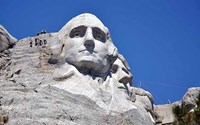- Lesson Plan (32)
- Student Activities (17)
- Other Education Materials (13)
- Field Trips (12)
- Teacher Reference Materials (12)
- Distance Learning (9)
- Primary Sources (3)
- Traveling Trunk (2)
- Field Schools & Institutes (1)
- Science Labs (1)
- Teacher Workshops & Other Programs (1)
- Mount Rushmore National Memorial (12)
- Glacier National Park (10)
- Mount Rainier National Park (8)
- Carl Sandburg Home National Historic Site (7)
- Acadia National Park (5)
- Fort Necessity National Battlefield (3)
- Yellowstone National Park (3)
- Eisenhower National Historic Site (2)
- Hawaiʻi Volcanoes National Park (2)
- Show More ...
- Social Studies (48)
- Science (34)
- Literacy and Language Arts (24)
- Math (16)
- 11-12.RH.1 (6)
- 9-10.RH.2 (6)
- 11-12.RH.4 (5)
- 6-8.RH.1 (5)
- 6-8.RH.2 (5)
- 9-10.RH.1 (5)
- 9-10.RH.10 (5)
- 9-10.RH.4 (5)
- 11-12.RH.2 (4)
- Show More ...
Showing 75 results for MT.SCI.K-12.3 ...
Math at Mount Rushmore for Grades 9, 10, 11 and 12
- Type: Student Activities ... Teacher Reference Materials ... Other Education Materials
- Grade Levels: High School: Ninth Grade through Twelfth Grade

Students calculate an estimate the weight of Mount Rushmore by calculating the volume using cross sections of the model, then use density of stone to finally arrive at a rough estimate of the weight. Finally, students calculate when two cracks on the surface of the sculpture would intersect over time.
Geometry at Mount Rushmore
- Type: Student Activities ... Teacher Reference Materials ... Other Education Materials
- Grade Levels: Lower Elementary: Pre-Kindergarten through Second Grade
Mount Rushmore as Scuplture
- Type: Student Activities ... Teacher Reference Materials ... Other Education Materials
- Grade Levels: Middle School: Sixth Grade through Eighth Grade
Preservation at Mount Rushmore
- Type: Student Activities ... Teacher Reference Materials ... Other Education Materials
- Grade Levels: Upper Elementary: Third Grade through Fifth Grade

Learn about the various preservation concerns at Mount Rushmore. By learning to recognize the various types of rocks found in Mount Rushmore and their different characteristics and varying rates of erosion, students will be able to understand the complexity of caring for a monument like Mount Rushmore.
Mount Rainier Institute
- Type: Field Schools & Institutes
- Grade Levels: Middle School: Sixth Grade through Eighth Grade

Mount Rainier Institute provides outstanding nature-based education experiences that are rooted in science and nurture the next generation of environmental stewards and leaders. School overnight programs immerse students in a rich learning environment where they explore the natural world, develop a connection to nature, and build community.
Senses Songs
What Is Wild?
Art Criticism and Mount Rushmore
- Type: Primary Sources ... Student Activities ... Teacher Reference Materials ... Other Education Materials
- Grade Levels: High School: Ninth Grade through Twelfth Grade
Art Alive! (Grades 9-12)
- Type: Other Education Materials
- Grade Levels: High School: Ninth Grade through Twelfth Grade

Students participating in a field trip at Weir Farm National Historical Park learn about the three generations of American artists who lived and painted her, and experience the authentic, untouched landscape that inspired them. Here are additional pre-visit and post-visit classroom activities for your students!
- Type: Traveling Trunk
- Grade Levels: High School: Ninth Grade through Twelfth Grade

The trunk includes curriculum materials, books, documents and a DVD that can be integrated into history, social studies, reading, and language arts curriculum. Additionally, the curriculum materials include student station sheets, so students can rotate stations without the teacher having to repeat instructions.
Soda Bottle Volcano and Mount Rainier
Fort McHenry Scavenger Hunt| K-12
Hampton NHS Scavenger Hunt| K-12
Virtual: Grades 9-12: Career Day
- Type: Distance Learning
- Grade Levels: High School: Ninth Grade through Twelfth Grade

Interview a ranger about a variety of National Park Service careers. Explore career options in science, law enforcement, search & rescue, teaching, graphics editing, management, accounting, history, cultural lands management, motor vehicle repair, heavy equipment operation, several trades, public policy, and more! Programs are tailored to each school’s needs. (45 minutes)
Carl Sandburg's Connemara (Grades 9-12)
- Type: Lesson Plan
- Grade Levels: High School: Ninth Grade through Twelfth Grade
Virtual Field Trip: The Mount Washington Tavern
- Type: Field Trips
- Grade Levels: Lower Elementary: Pre-Kindergarten through Second Grade

This virtual tour of the Mount Washington Tavern can be used along with the lessons in the teacher's guide"Traveling the National Road." The students will see pretend characters from the past, who talk about the different rooms in the tavern and what life was like during the hey-day of the National Road.
Electrical Conductivity STEM Backpack, Grades 9-12
- Type: Field Trips
- Grade Levels: High School: Ninth Grade through Twelfth Grade

This set of field equipment is designed to be used on the trails of Kaloko-Honokōhau National Historical Park with Ranger supervision. The electrical conductivity measurements quantify the salinity of the various types of water encountered along the parkʻs hiking trails. The backpack can be used with The Waters of Kaloko-Honokōhau Self-Guided Trail booklets, included in the backpack.
Anchialine Pools STEM Kit, Grades 9-12
Math at Mount Rushmore for Grades 3, 4 and 5
- Type: Student Activities ... Teacher Reference Materials ... Other Education Materials
- Grade Levels: Upper Elementary: Third Grade through Fifth Grade
Math at Mount Rushmore for Grades 6, 7 and 8
- Type: Student Activities ... Teacher Reference Materials ... Other Education Materials
- Grade Levels: Middle School: Sixth Grade through Eighth Grade

Students recognize shapes in Mount Rushmore, whether it’s 2D shapes through a series of 2D drawings, or 3D shapes through measurable PDF’s of the 3D model of Mount Rushmore. Learners use geometric formulas to calculate the volumes of these shapes based on scaled representations and effectively use understanding of scale to translate these calculations to life-size.











